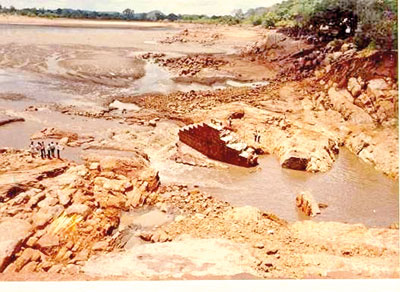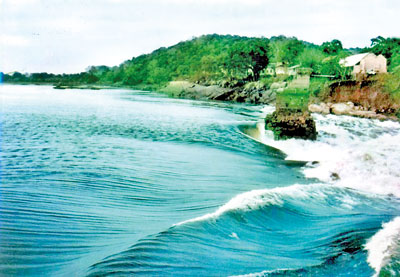Dam Safety: Not only the responsibility of professionals

Kantale Dam Failure –view of empty reservoir and remnants of dam
More than 30 years have now passed after the Kantale dam breach that happened in April 1986. Even though the rest of the country has forgotten that incident in which 130 people lost their lives, nearly 600 private and government buildings were totally destroyed, another 630 buildings partly damaged, agriculture, roads and other infrastructure washed away, survivors and officers can still remember the devastation and agony of the aftermath.
The cost of relief work and rehabilitation of infrastructure was Rs. 525 million during that time, which would be approximately Rs. 9 billion at present value.
Can anyone ensure that a similar disaster in future will not happen? Whose responsibility is prevention or mitigation of such disaster? Let us get some idea about causes of dam disasters and responsibilities of various sectors in minimising the risks.
A dam is considered as the most hazard prone man-made structure, amongst all the civil engineering structures. Failure of a single large dam can cause loss of thousands of lives, billions worth of property and priceless environment instantly. Many countries, including developed countries, have faced this horrendous experience.
A dam can fail with or without prior warning due to an inherited weakness, a gradually developed weakness or as a result of a natural phenomenon such as heavy storm, landslide or earthquake. Hence it is difficult to design a dam with a zero probability of failure.
How vulnerable are those who live in the shadow of dams is a question frequently ask specially during stormy seasons when the reservoirs are full. It is very common that rumours get spread during bad weather conditions over breach of dams specially located in higher elevation of populated cities such as Anuradhapura or Polonnaruwa causing people to panic and look for authentic information. One basic issue is that people have not been made aware of the danger prone area in case of a failure in advance.
Whether a dam is made of earth, concrete or combination of rock and core material, a dam is susceptible for aging, similar to a living being. It has a certain life span, which can be extended with proper maintenance, upgrading and correct operation of associated structures. If proper attention is not given, the life span will become less than the specified period. Very much similar to human beings dams too should go through proper examinations/ surveillance by specialists with periodic healthy treatments and continuous testing to be done to track illnesses.
Statistics show that the highest number of dam failures have occurred globally due to overflow during heavy storms. Hence the excess incoming water has to be released safely through the spill in properly controlled manner. Water release from a breach of small village reservoir will be sufficient to trigger a large dam failure. This is inevitable with the topographical conditions in our river basins, in which the dams are located in close proximity. Sri Lanka experienced this episode during the 1957/58 floods when 35 large dams, 53 medium dams and 1500 small dams breached during a heavy storms received in NP, NCP, CP and NWP.

Kantale reservoir-during the failure
Spillways in large dams were upgraded after this incident, by incorporating radial gates for the engineers to manage the inflow and outflow of the reservoir according to a pre-determined rules, without allowing the water to have their own paths. However vulnerability for failure does not end with the provision of the gates as these gates need to be maintained and even upgraded to meet the changes in climate and ecology. With the changing hydrological conditions due to climate change variations, it has been observed the intensity of the rainfall getting higher and within a short time water level in reservoirs too raises very fast. The reduction in forest cover in catchments has escalated this process. Hence the adequacy of the spillways have to be studied by the authorities periodically to ensure safety of dams during floods.
Prior warning also has to be handled by those operating the dams and mechanisms have to be put in place so that in case of troubled signs the people in the vulnerable areas must be informed in the shortest possible time. It is also necessary to identify the evacuation centres and paths and people be made aware of those. Society need to be aware and be prepared to face such an event as a team.
Dam safety cannot be a standalone programme. It should be a part of a regional development strategy in the locality. Not only the dam managing organisations but the other government organisations make use of the reservoirs for services other than in original plan (inland fishing, domestic water supply, tourism. etc) and they too have a responsibility for safety of the dams realising the vulnerability. They should reap the benefit from the reservoir without making any threat to the safety of the dam. Boats used for fishing, tourism, etc and the water intakes to be located at safe places should be without disturbing the safety standards.
It is difficult to be prescriptive when making decisions during emergencies as one has to consider the risk to the public as well as economic, environmental, social, and cultural impacts. The technical analysis of risks associated with a dam cannot become the sole decision-making factor. Hence all those stakeholders should participate in finalising the emergency preparedness plans, sharing their input in all these aspects and be prepared to follow the agreed plan when a warning is issued. Prevention of disaster and mitigation of impacts can be achieved only through such a collective action.
When the public uses the reservoir for bathing and washing they must adhere to the designated places without disturbing the bund slope or riprap. The earth bund should not be selected for tree planting campaigns. Trees can do much harm to the integrity of the dam. Encroachment of dam reservations and blocking the inspection paths is a very common issue in Sri Lanka. While it would be the responsibility of the engineers to make sure the dam is kept in a healthy condition, the support of the other stakeholders and the public is necessary to achieve results.
| IESL contribution to development This is part of a continuing series in the Business Times by the Institution of Engineers of Sri Lanka (IESL) where its members share their thoughts and views on matters of national importance. The writer is a retired Director General of Irrigation. |


